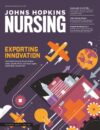By Steve St. Angelo | Illustrations by Shaw Nielsen
What happens in Baltimore doesn’t stay in Baltimore, which is good for healthcare across the globe
To many who call it home, Baltimore is the world. Take the many Hopkins nurse leaders and researchers who are using what they learn in the city to develop care strategies and practices and adapting them to improve the health of populations across the globe, transferring innovation overseas.For better and worse, Baltimore offers nurses prime training ground for pretty much the entire spectrum of healthcare as its racially, ethnically, religiously, socioeconomically diverse citizenship moves through communities built in expensive homes and neglected neighborhoods, on its streets, in shelters, prisons, and hospitals, in some of the best and worst schools of the nation. The city, then, offers a microcosm of what nurses will face as they begin to stake out new territory the world over. Start with simple fairness or, in research parlance, social determinants of health (SDH).
“There is increasing awareness that the benefits of advances in prevention and treatment have not been shared equally across economic, racial, and ethnic groups in the United States. Overall population health cannot improve if parts of the population do not benefit from improvements in prevention and treatment,” warns a study on cardiovascular disease in the journal Circulation co-authored by Associate Professor Cheryl Dennison Himmelfarb, PhD, RN, ANP.
Dennison Himmelfarb, co-director of the Center for Cardiovascular and Chronic Care, says such social factors as education, income, and race threaten to short-circuit great advances made against heart disease and many other ills. The report also describes nurses as critical to shaping the healthcare system of the future.
“Overall population health cannot improve if parts of the population do not benefit from improvements in prevention and treatment.”
— Cheryl Dennison Himmelfarb in Circulation
One key step, according to Dean Patricia Davidson, PhD, MEd, RN, is “putting the community in the curriculum” as well as putting the curriculum to work in the community, no matter where that might be. In a world where ZIP code can be as important as genetic code, preparing health professionals to practice to the top of their licenses requires great sensitivity, not to mention a great deal of humility.
Davidson singles out the initial Hopkins-taught cohort of Doctor of Nursing Practice candidates at Johns Hopkins Aramco Healthcare (JHAH) in Saudi Arabia—the first ever for that kingdom—as leaning upon a principle honed in Baltimore: cultural sensitivity. (JHAH is the result of a joint venture between Saudi Aramco, a world leader in energy, and Johns Hopkins Medicine.)
As in many parts of the world, nursing practice at JHAH has the opportunity to develop toward the model in the United States, Canada, and Europe, where advanced nursing practice helps to extend physician care, eases the effects of the shortage of healthcare workers, and creates more attractive career paths for nurses that improve recruitment and retention efforts.
JHAH, which cares for Saudi Aramco’s 350,000 internationally diverse employees and dependents, is eager to provide top-flight healthcare and understands the value of investing in the advancement of nurses, points out Phyllis Sharps, PhD, RN, associate dean for community and global programs. “Considering the diversity of both the cohort and the patient population, we adapted our DNP program to the local environment and send faculty to Saudi Arabia on a regular basis so the students can learn on site.”
What will attract future nurses to embrace such challenges “is a commitment to being a citizen of the world, to offering the best care to anyone, anywhere,” Sharps says, adding that acceptance will grow as the benefits of the program become obvious. “You need well-educated nurses and nurse leaders to provide the highest quality medicine that you want for your patients. The DNP is that kind of degree of practice. At Johns Hopkins in Baltimore, we know how to build nurse leaders. The innovation here is taking what we know and putting it into that environment.”
“It’s not so different from the PhD Program Partnership between Peking Union Medical College [or PUMC] and the Hopkins School of
Nursing,” she explains of the first doctoral nursing program in China, successfully launched despite long-standing tensions between that communist nation and the United States.
“From the outset of our partnership with PUMC, we were sensitive to the political and cultural differences between the U.S. and China,” says Marie Nolan, PhD, RN, executive vice dean, who served as the Hopkins director of a program founded by Dean Emerita Martha Hill, PhD, RN, in 2004. For example, individuals with serious mental illness and their families suffer from an even greater stigma and lack of treatment in China than those in the U.S. and are rarely seen in public. “It was important, therefore, that it was the passion of one of the PUMC students and her faculty adviser to study self-management in patients with schizophrenia and their families. Their work revealed that persons with serious mental illness can play an important role in their treatment and can be integrated into society.”
Adds Nolan, “Politics in Baltimore impact healthcare as they do in other U.S. cities or in China. Respecting the ability of the members of the community to identify their own healthcare priorities is essential to creating a path forward to develop innovative approaches to care that improve lives exponentially.”
GOOD FOR ALL
Associate Professor Jason Farley, PhD, MPH, ANP-BC, lives in two worlds. As clinical core co-director of the Johns Hopkins Center for AIDS Research, he helps nurture a new generation of researchers with an emphasis on interdisciplinary work. Farley also has an adjunct appointment on the faculty at the University of KwaZulu Natal, South Africa, a nation where HIV and tuberculosis are an often deadly combination. Farley feels innovation to address such conditions “goes both directions.”
For instance, “I took our nurse practitioner model that we have [at Hopkins] and tailored it for the South African primary healthcare context, specifically for multidrug-resistant tuberculosis. In that context, the disease was only a physician-managed process. [Since physicians are mainly in big urban hospitals, this meant arduous journeys for very ill patients from surrounding areas.] By designing this program, which is really patient-centered, we could have care by nurse practitioners delivered closer to home.” An abstract for the pilot program will be presented at a meeting of the International Union Against Tuberculosis and Lung Disease in December. “The interesting thing is that we returned this model to the U.S. for my HIV nurse practitioner program through our Health Resources and Services Administration-funded AIDS Education Training Center.”
Success brings its own challenge, Farley explains. The resistance that greeted the TB pilot in 2009 has turned into an embrace, with a growing demand for more. “Now we’re funded by the Global Fund to expand the intervention countrywide in South Africa … the issue is scale-up, getting people trained fast enough.”
INNOVATION BEGINS AT HOME
Meanwhile, a series of smartphone applications that Farley designed to help South African TB patients get and stay linked to care and maintain strict drug regimens (while allowing caregivers to track them) is being adapted for HIV prevention in Baltimore City as part of a $20 million CDC grant to the Health Department. It’s a clear demonstration that both educational initiatives and cutting-edge technological innovations can be exported back to the U.S.
Many patient-care innovations in Baltimore start with a simple premise: Reach individuals or groups and you can begin to reach and help their communities.
The Johns Hopkins medical campus sits in the middle of one of the city’s most historically underprivileged neighborhoods, where access to fresh food and healthy lifestyle choices can be a challenge. Recent unrest in the city, though not specifically in East Baltimore, only underscored the sense of frustration and desperation of African American residents.
Chronic health conditions and “multiple morbidities” in the adult population are quite often the result of lax or non-existent healthcare and proper nutrition from the very beginning of life. It’s obviously more difficult to treat maladies once they become chronic, so helping the community means going through the children.
Henderson-Hopkins, the first public school built in East Baltimore in decades, was structured to give a good education to youngsters in kindergarten through eighth grade and to become an integral part of the community. Through work in the school’s health suite (still navigating a few logistical and regulatory issues), faculty and nursing students will promote the behavioral, cognitive, and physical health of children.
In return, they will improve their own critical thinking skills and problem solving and ultimately become better nurses, Sharps says. The idea is that Henderson-Hopkins can one day become a model for similar programs in schools across Baltimore and the nation.
THE NEXT WAVE
As the world becomes an ever more interconnected place, it is essential to keep innovation moving through the nursing pipeline. This summer’s Supreme Court decision to uphold the Affordable Care Act in King v. Burwell means that 16.4 million newly insured Americans will keep their health insurance. Combine that explosion of new patients with the Institute of Medicine’s prediction of a shortage of physicians as perhaps one-third of current MDs retire over the next 10 years. The justices merely confirmed that a new day of nursing has arrived. Dean Davidson has rushed to greet it.
“Our new [Master of Science in Nursing: Entry into Nursing] curriculum was part of our anticipation of and initial response to the Affordable Care Act,” she wrote in an op-ed after the ruling. “We’ve just enrolled our initial class of bright, driven students who will receive the education and tools to become the advanced bedside nurses, hospital leaders, faculty, and researchers we need now.”
The MSN: Entry into Nursing, a five-semester journey that takes students “from wherever you are in the world—and in your life—to wherever you want to go,” according to Davidson, is built for career changers as well as those who’ve come to nursing from a very different place.” You need to see the connectedness of us all, globally. You need to feel at some level commitment to address inequities wherever.”
— Phyllis Sharps
Sharps, also director of the Center for Global Nursing, cites Returned Peace Corps Volunteers as a key potential part of the next wave of global citizen/nurses. These are students who have lived amid underserved communities abroad, learned cultural sensitivity and “the value of good healthcare” through their travels, and see nursing as a way to get back out into the world and play a bigger part.
“You need to see the connectedness of us all, globally,” Sharps says. “You need to feel at some level commitment to address inequities wherever.”
Baltimore is as good a place as any for innovation to start. Where it ends up could
be anywhere in the world.

